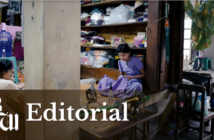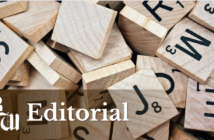‘Ally’ is an easy word to say, but a hard word to define. Buttons and stickers publicly display the compact, four-letter word, but who are the people it describes, and what do they do?
As Dr. Trish Boyles, the director of the Pride Center for Sexual Orientation & Gender Diversity, says, many qualities that typically describe allies are abstract or passive, such as being supportive or open-minded. It’s challenging to try to then translate those characteristics into concrete actions. How do you “act open-minded”? It’s easy to pledge support, but what does that support entail? What are some things that people who want to be allies and support the LGBT community can do in everyday terms, and how does that concept apply to Lehigh?
There seem to be a lot of misconceptions around what it means to be an ally. Within the student body, it’s sometimes thrown around as a label, and students don’t always understand what it implies or its importance.
Eryne Boyle, ’15, a student program coordinator for the Pride Center for Sexual Orientation and Gender Diversity, said, “I don’t think the role allies play in creating a welcoming environment for LGBT students could possibly be overstated.” Boyle emphasizes that “having allies around campus alleviates the burden felt by LGBT-identified students to solely hold other students accountable for their language and actions.”
Allyship is an important role, yet some students don’t necessarily know how to be an ally. A lot of students assume that it’s the absence of hate instead of the addition of actual support.
Being an ally requires action. “You can still be supportive and not be an ally,” Boyles explains. “It’s a conscious choice of ‘I’m going to take some action to change things.’ Whereas being supportive is ‘I hope things change.'”
Students can strive to be more active allies and figure out how to do that in their own personal ways. The most fundamental step toward being an ally is becoming informed. The Pride Center for Sexual Orientation and Gender Diversity and the Rainbow Room are two on-campus places where students can seek information.
The Rainbow Room is sometimes misinterpreted as solely for students who identify as LGBTQIA, and students who do not identify as such might feel that they are unwanted. But those students are forgetting the second meaning of the “A” in LGBTQIA: ally. “The students who are using those spaces want other students from Lehigh to come in even if they don’t identify with a particular identity that that room is supposed to support,” Boyles said.
Students can also educate themselves through other resources, such as books, videos and online sources of information. Students who don’t identify as LGBTQIA but want to support that community should be familiar with specific pronouns, gender identifications and sexual orientations and understand why they are significant.
Liz Pines, ’16, another student program coordinator for the Pride Center, warned that while research can help students understand some of the issues, they should not “expect to have a one-size-fits-all approach to dealing with LGBT issues, especially because so many LGBT issues are intertwined with race and class.” She cited workplace discrimination, injustice in the legal system, violence, harassment and murder as examples of the breadth and depth of LGBT issues.
This is probably one of the hardest aspects of allyship to grasp. Being an ally means being flexible, accepting different opportunities to be supportive and adjusting to fit the needs of specific situations.
“One thing I think is really important to remember is that allyship looks different to everyone because the spectrum of identities is vastly different,” Pines said. “Allyship is multidimensional, and being an ally to a gay white man is very different than being an ally to a trans woman of color.”
Being an ally requires students to look inward and recognize their own biases or less obvious ways that they inadvertently promote stereotypes and discrimination. Self-awareness entails evaluating personal beliefs and consciously avoiding assumptions about others. Boyles provided the example of when a student meets a male student and immediately asks whether he has a girlfriend, which promotes the underlying assumption that he is heterosexual.
Sexual orientation and gender identity are very intimate, personal issues. Students should treat everyone that they meet with respect and not assume that they’re one specific sexual orientation or gender identity. Students might not even know for themselves how to identify, so how could someone else possibly make accurate assumptions about them?
Boyles says, “Being an ally is hard work.” She explains that it requires students to become aware of their own personal biases and how they’re contributing to the problems.
Realizing the negative effects of your actions, though an uncomfortable experience, is by no means a bad thing. Perspective leads to change — both on a personal and communal level.
In short, being an ally is nowhere near as easy as simply pinning a button to your book bag, but it’s not impossible, either. So don’t shy away from the challenge — become a visible ally on campus and turn your support into action.





Comment policy
Comments posted to The Brown and White website are reviewed by a moderator before being approved. Incendiary speech or harassing language, including comments targeted at individuals, may be deemed unacceptable and not published. Spam and other soliciting will also be declined.
The Brown and White also reserves the right to not publish entirely anonymous comments.
1 Comment
Yes, please, allyship is important, especially if you work at it.
But the A in LGBTQIA stands for Asexual, not Ally – please do not erase other peoples identities in order to fit your own.